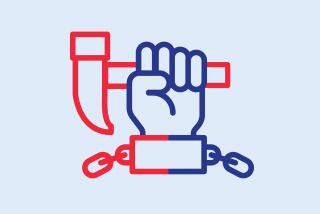Make the time fit the crime
What’s prison for, anyway? Is it to change people, to punish them, or simply to remove them from the streets? If the number of cells is finite — and it is — society had better figure out its reasons for selecting whom it locks up and how long it holds them.
Unfortunately, states and the federal government have done a poor job of defining just what they want from their prisons. That sort of philosophical fumbling was brought home again with a recent report from the American Civil Liberties Union that found 3,200 people in nine states serving sentences of life without parole for nonviolent crimes. That’s prison until death for offenses as minor, in some cases, as shoplifting.
Judges often have no choice but to hand down such excessive terms under mandates, much like California’s three-strikes law, meant to ensure harsh punishment for repeat offenders. But if the point is to get the thief to stop stealing, a lifetime behind bars is an absurdly expensive — not to say outrageously harsh — way to get the job done. Only the most dangerous offenders, chiefly those who would perpetrate violence, should be locked away forever.
California voters came closer to just and workable repeat-offender laws a year ago when they modified the existing three-strikes law so that the longest terms — 25 years to life — would go only to those whose final “strike” was a serious or violent crime. But thousands of people remain “incapacitated” in prison across the nation for life for relatively minor offenses, in part because lawmakers desperate to deal with crime forgot about the criminal justice system’s role beyond simple punishment.
For most offenders, lockup is, and ought to be, temporary. Their sentences exact a measure of societal retribution but should also get them to change their behavior when they reenter society. And together with incapacitation, retribution and deterrence, rehabilitation — a change that comes with education, skills training, cognitive behavioral therapy and, where appropriate, substance-abuse treatment — is a legitimate and necessary part of the justice system.
It would be naive to believe that every offender, even every nonviolent offender, can be rehabilitated. Society needs prisons to protect itself, to punish and to deter. But it is foolhardy to lock up felons for unreasonably long periods, clogging prisons, wasting taxpayer dollars and failing to establish a coherent connection between the sentence and what it is supposed to accomplish.
More to Read
A cure for the common opinion
Get thought-provoking perspectives with our weekly newsletter.
You may occasionally receive promotional content from the Los Angeles Times.










